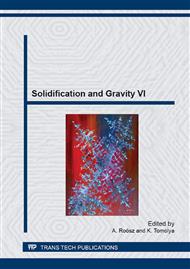[1]
M. Rettenmayr, Melting and remelting phenomena, Int. Mater. Rev. 54 (2009) 1-17.
Google Scholar
[2]
J.G. Dash, Surface Melting, Contemp. Phys. 30 (1989) 89–100.
Google Scholar
[3]
S.J. Fensin, D. Olmsted, D. Buta, M. Asta, A. Karma, J.J. Hoyt, Structural disjoining potential for grain-boundary premelting and grain coalescence from molecular-dynamics simulations, Phys. Rev. E 81 (2010) 031601.
DOI: 10.1103/physreve.81.031601
Google Scholar
[4]
S.W. Chan, J.S. Liu, R.W. Balluffi, Test for a possible melting transition in grain boundaries in Al near the melting point, Scripta Metall. 19 (1985) 1251-1255.
DOI: 10.1016/0036-9748(85)90248-0
Google Scholar
[5]
S. Terzi, L. Salvo, M. Suery, E. Boller, In-situ X-ray microtomography characterization of the entrapped liquid formed during partial remelting of a cold-rolled Al-8 wt. % Cu alloy, Scripta Mater. 60 (2009) 671-674.
DOI: 10.1016/j.scriptamat.2008.12.042
Google Scholar
[6]
S. Fischer, M. Rettenmayr, Observation of early melting stages of Al-Cu alloys in a temperature gradient, Int. J. Mater. Res. 102 (2011) 1226-1231.
DOI: 10.3139/146.110576
Google Scholar
[7]
S. Fischer, M. Rettenmayr, Observation of the formation of liquid droplets in steep temperature gradients, J. Phys. Conf. Series: Mater. Sci. Eng. 27 (2011) 012019.
DOI: 10.1088/1757-899x/27/1/012019
Google Scholar
[8]
D.N. Yoon, W.J. Huppmann, Chemically driven growth of W grains during sintering in liquid Ni. Acta Metall. 27 (1979) 973–977.
DOI: 10.1016/0001-6160(79)90185-8
Google Scholar
[9]
W.H. Rhee, D.N. Yoon, The grain boundary migration induced by diffusional coherency strain in Mo-Ni alloy, Acta Metall. 37 (1989) 221–228.
DOI: 10.1016/0001-6160(89)90280-0
Google Scholar
[10]
M. Kuo, R.A. Fournelle, Diffusion induced grain-boundary migration (DIGM) and liquid film migration (LFM) in an Al-2. 07wt. % Cu alloy, Acta Metall. Mater. 43 (1991) 2835-2845.
DOI: 10.1016/0956-7151(91)90101-6
Google Scholar
[11]
J.S. Kirkaldy, Liquid film migration as a broken symmetry due to an unbalanced anisotropy of surface tension, Acta Mater 46 (1998) 5127-5133.
DOI: 10.1016/s1359-6454(98)00157-8
Google Scholar
[12]
M. Hillert, M. Rettenmayr, Deviations from equilibrium at migrating phase interfaces, Acta Mater. 51 (2003) 2803-2809.
DOI: 10.1016/s1359-6454(03)00085-5
Google Scholar
[13]
M. Buchmann, M. Rettenmayr, Rapid solidification theory revisited – a consistent model based on a sharp interface, Scripta Mater. 57 (2007) 169-172.
DOI: 10.1016/j.scriptamat.2007.02.039
Google Scholar
[14]
J. Svoboda, E. Gamsjäger, F.D. Fischer, P. Fratzl, Application of the thermodynamic extremal principle to the diffusional phase transformations, Acta Mater. 52 (2004) 959-967.
DOI: 10.1016/j.actamat.2003.10.030
Google Scholar
[15]
S.G. Kim, W.T. Kim, T. Suzuki, Phase field model for binary alloys, Phys. Rev. E 60 (1999) 7186-7197.
DOI: 10.1103/physreve.60.7186
Google Scholar


